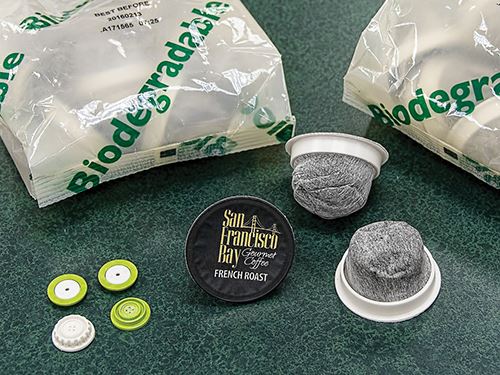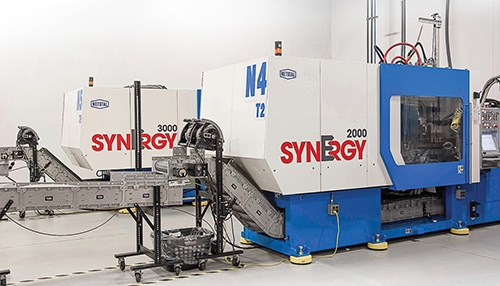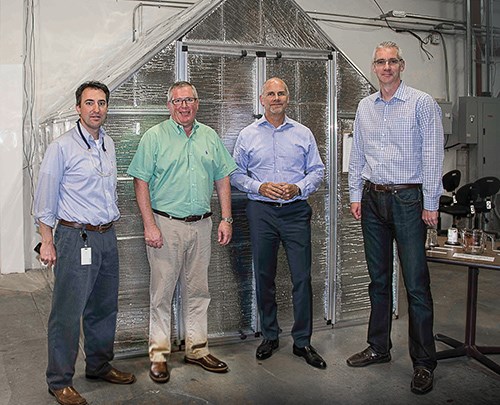Betting on Biopolymers
A new injection molding business is focused 100% on compostable, plant-based polymers.
“Committed to compostables” describes both the business focus and guiding philosophy of a new custom injection molding business dedicated to “green” materials. UrthPact is one of the pioneers in processing these notoriously challenging materials. In January 2014, it was spun off as a separate company from Innovative Mold Solutions (IMS), a custom molder and contract manufacturer in Leominster. Both firms are located in the same building and are owned by Paul Boudreau, a former engineering manager at Husky Injection Molding Systems.
Explains Boudreau, “IMS has always been an engineering-oriented company. We develop new, innovative technologies. We do the impossible. About 10 years ago, IMS started dabbling in bioplastics. Last year, we formed UrthPact as a separate company with the mission of using plant-based biocompostable plastics.
“Manufacturers have a responsibility to the planet. Our team is all avid outdoors people. We have a passion for cycling, and we see the trash on the roadsides, and we wanted to help do something about it. We also asked ourselves, why use plastics made from oil, when renewable materials are being developed?”
Says Derek Helmer, v.p. of business development (another Husky alumnus), “We use mainly blends of PLA and PHA. PHA does a good job of improving the properties of PLA; for example, PHA has better heat resistance and barrier to moisture and gases. Within the next year, we may begin molding straight PHA, which has its own challenges. We expect it will be more cost-effective than PLA once production is scaled up.” UrthPact uses PHA from MHG, Bainbridge, Ga..
NOT FOR THE FAINT OF HEART
“We quickly found out all the reasons why most people don’t want to mold plant-based materials,” says Boudreau. Adds Helmer, “They don’t behave like typical thermoplastics. If you’re thinking like an injection molder with 20 to 30 years’ experience, you’ll get it wrong. Where you would think to add heat or pressure—these materials need the opposite.
“Typical thermoplastics have very little MFI variation, but these materials vary by 2 to 5 points. They also have a steeper shear-rate/viscosity curve. And the process isn’t over when we’re done molding a part. To get the physical properties our customers are looking for requires post-crystallization.”
“We decided to stop complaining about the materials’ behavior and waiting for someone else to solve this. Our job is to figure out how to deal with it in our process.”
Boudreau credits this hard-won processing know-how with helping overcome the cost premium for biopolymers. “We compete with PP, PE, PS, and PET. Biopolymers have come down in price but are still not on par with these conventional materials. We decided we couldn’t wait until they hit par. We saw that processing waste, rejects, and limited molding speeds added to the overall cost of compostable products, so we addressed those limitations with our knowledge of high-speed, precision injection molding.”
“For example, we regularly use hot runners,” points out Mike Pousland, v.p. of operations. “The hardware manufacturers were hesitant to tackle biopolymers, but we pushed them on behalf of our customers.”
UrthPact also paid for testing of some biopolymers to derive the data necessary for computerized flow simulation. Adds Boudreau, “We also developed product designs to use less material and put material where it’s most useful.” In addition to Design for Manufacturability, UrthPact applied what Boudreau calls “Design for Compostability.” By the latter he means avoiding excessive wall thickness that could compromise a product’s ability to decompose in the standard 90 days.
As UrthPact climbed the steep learning curve, it assembled a portfolio of proprietary processing technology, which it is open to licensing to other processors. “Our goal is to promote this technology,” says Boudreau. “Processing these materials is not just shoot-and-ship. It requires special expertise.”
COMMERCIAL DEBUT
“Our market is single-use consumer packaging,” says Boudreau. “Our value proposition is the use of renewable materials and their ability to be composted after use.”
UrthPact’s first commercial application is a replacement for the popular coffee “pod” for single-cup brewing, such as the Keurig K-Cup and competing products. Such pods are generally made of polystyrene with an aluminum lid, though some biodegradable versions have appeared on the market. According to some reports, as many as 9 billion of these pods are headed for landfills each year. “The coffee pod is five minutes of convenience and then it will be around for 500 years.”
UrthPact teamed up with San Francisco Bay Coffee, Oakland, Calif., to develop a substitute that is more than 97% compostable by weight. Instead of a cup, it consists of a rigid ring of biopolymer attached to a “teabag”-style filter container that holds the ground coffee. UrthPact also molds the degassing valve of biopolymer. The lidding film over the ring and the outer bag packaging are made from biopolymer by Ultra Flex Packaging in Brooklyn, N.Y. This package, which fits Keurig and other single-cup brewing systems, was launched in 2013.
UrthPact is working on five other projects for single-use disposables, one or two of which will launch this year, Boudreau expects. He sees these applications sustaining double-digit growth for his new venture.
EXPANDING PRODUCTION
UrthPact currently has six injection presses of 100 to 350 tons in Leominster. Five are Netstal Synergy hydraulic presses, and one is from Sumitomo (SHI) Demag. The plant covers 30,000 ft2 and employs 40 people. Boudreau plans to add two more presses this year; the plant has room for up to 10.
UrthPact started up a second plant in Lincoln, Calif. (near Sacramento), in July. It has one injection machine but three more are planned for this year, and the 42,000 ft² plant can hold 15. It will employ 15-20 this year.
In Leominster, UrthPact has two automated cells for assembling degassing valves, and two more will be added by the end of the year. drop out of the molds onto conveyors equipped with cooling fans and camera inspection. The coffee-pod rings are subjected to 100% vision inspection for dimensions, ovality, short shots, and flash.
The conveyors are supplied by Dynamic Conveyor Corp., Muskegon, Mich. Adam Parker, v.p. of manufacturing, says the modularity and reconfigurability of the DynaCon conveyors was a key advantage in setting up this plant and the one in California. “With other conveyors, we had to delay the purchase until we could figure out the ideal production layout. But the DynaCon conveyors are so flexible that we can bring them in early and figure out how we might reconfigure them later. We’re not locking ourselves in—we can experiment to find exactly what we want.”
Sean Wright, manufacturing engineer, concurs: “With rapid growth like ours, it’s important to be able to reconfigure our auxiliary equipment and do an R&D project without the conveyor systems. The DynaCon conveyor is like a large erector set—we can reconfigure it as needed instead of being stuck with one fixed system. It allowed us to revamp the entire postmolding process.”
As an example, Wright notes that the conveyor belts were ordered originally with flights spaced at 12-in. intervals, but that did not separate the parts as planned. He was able to order additional flights and rebuild the belt. “We were able to pull the belt completely off and add twice the number of flights in about an hour. With another conveyor-belt system that would not be possible because the flights are typically permanently attached and cannot be adjusted.”
Parker notes another advantage: “Most conveyors are custom built, but these are standard modules.”
UrthPact has a quality lab equipped with a coordinate measuring machine and an optical comparator. Some parts, like the coffee degassing valve, have tolerances as tight as ±0.5-1 mil.
A more unusual QC testing capability at UrthPact is a specially built composting room with controlled temperature and humidity for testing compostability according to ASTM D6400.
Related Content
Pregis Performance Flexibles: In the ‘Wow’ Business
Pregis went big and bold with investment in a brand-new, state-of-the-art plant and spent big on expanding an existing facility. High-tech lines, well-known leadership and a commitment to sustainability are bringing the “wow” factor to blown film.
Read MoreHow to Extrusion Blow Mold PHA/PLA Blends
You need to pay attention to the inherent characteristics of biopolymers PHA/PLA materials when setting process parameters to realize better and more consistent outcomes.
Read MoreCompatibilizers Aid Recycling & Upcycling of Mixed Resins
Compatibilizers are proving their worth in boosting critical properties such as impact/stiffness balance of PCR and PIR blends of polyolefins and other plastics.
Read More‘Monomaterial’ Trend in Packaging and Beyond Will Only Thrive
In terms of sustainability measures, monomaterial structures are already making good headway and will evolve even further.
Read MoreRead Next
Advanced Recycling: Beyond Pyrolysis
Consumer-product brand owners increasingly see advanced chemical recycling as a necessary complement to mechanical recycling if they are to meet ambitious goals for a circular economy in the next decade. Dozens of technology providers are developing new technologies to overcome the limitations of existing pyrolysis methods and to commercialize various alternative approaches to chemical recycling of plastics.
Read MoreLead the Conversation, Change the Conversation
Coverage of single-use plastics can be both misleading and demoralizing. Here are 10 tips for changing the perception of the plastics industry at your company and in your community.
Read MoreWhy (and What) You Need to Dry
Other than polyolefins, almost every other polymer exhibits some level of polarity and therefore can absorb a certain amount of moisture from the atmosphere. Here’s a look at some of these materials, and what needs to be done to dry them.
Read More



























.png;maxWidth=300;quality=90)







